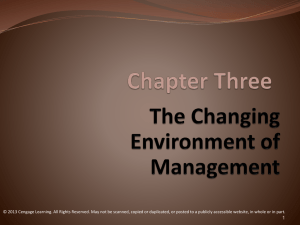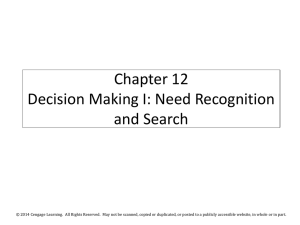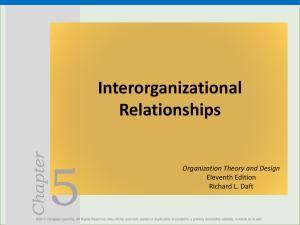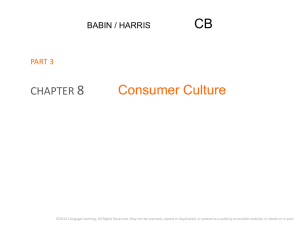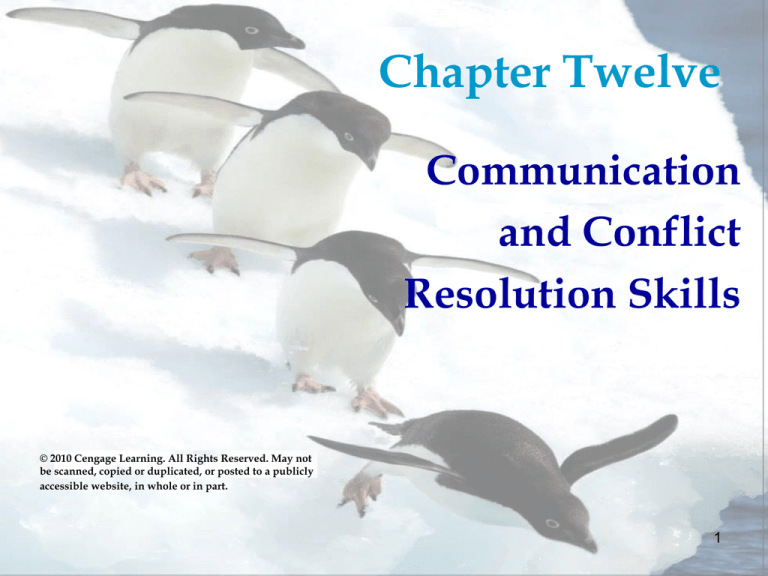
Chapter Twelve
Communication
and Conflict
Resolution Skills
© 2010 Cengage Learning. All Rights Reserved. May not
be scanned, copied or duplicated, or posted to a publicly
accessible website, in whole or in part.
1
Learning Objectives
Explain why good communication
skills contribute to effective
leadership.
Describe the basics of inspirational
and emotion-provoking
communication.
Describe key features of a poweroriented linguistic style.
Describe the six basic principles of
persuasion.
© 2010 Cengage Learning. All Rights Reserved. May not be scanned, copied
or duplicated, or posted to a publicly accessible website, in whole or in part.
2
Learning Objectives (cont’d)
Describe the elements of supportive
communication.
Be sensitive to the importance of
overcoming cross-cultural barriers
to communication.
Identify basic approaches to
resolving conflict and negotiating.
© 2010 Cengage Learning. All Rights Reserved. May not be scanned, copied
or duplicated, or posted to a publicly accessible website, in whole or in part.
3
Communication and Leadership
Effective leaders are also effective
communicators
To be effective, the leader must
synchronize verbal and nonverbal
behavior
Technology has had a meaningful
impact on leaders’ communication
and coordination
© 2010 Cengage Learning. All Rights Reserved. May not be scanned, copied
or duplicated, or posted to a publicly accessible website, in whole or in part.
4
Inspirational Speaking and Writing
(from Table 12-1)
A - A Variety of Inspirational Tactics
1. Be credible
2. Gear your message to the listener
3. Sell group members on the benefits of
your suggestions
4. Use heavy-impact and emotionprovoking words
5. Use anecdotes and metaphors to
communicate meaning
© 2010 Cengage Learning. All Rights Reserved. May not be scanned, copied
or duplicated, or posted to a publicly accessible website, in whole or in part.
5
Inspirational Speaking
and Writing (cont’d)
A - A Variety of Inspirational Tactics
(cont’d)
6. Back up conclusions with data (to a
point)
7. Minimize language errors, junk words,
and vocalized pauses
8. Write crisp, clear memos, letters, and
reports, including a front-loaded
message
9. Use business jargon in appropriate
doses
© 2010 Cengage Learning. All Rights Reserved. May not be scanned, copied
or duplicated, or posted to a publicly accessible website, in whole or in part.
6
Inspirational Speaking
and Writing (cont’d)
B - Use a Power-Oriented Linguistic
Style
1.
2.
3.
4.
Speak loudly enough
Downplay uncertainty
Use the pronoun “I”
Minimize the number of questions you
ask
5. Minimize self-deprecation
6. Offer negative feedback directly
7. Make your point quickly
© 2010 Cengage Learning. All Rights Reserved. May not be scanned, copied
or duplicated, or posted to a publicly accessible website, in whole or in part.
7
Inspirational Speaking
and Writing (cont’d)
B - Use a Power-Oriented Linguistic
Style (cont’d)
8. Speak directly, not indirectly
9. Weed out wimpy words
10. Know exactly what you want
11. Set the agenda and make listeners
comfortable
12. Be bold in your statements
13. Increase your listener’s receptivity through
effective framing
© 2010 Cengage Learning. All Rights Reserved. May not be scanned, copied
or duplicated, or posted to a publicly accessible website, in whole or in part.
8
Six Principles of Persuasion
1. Liking: People like those who
like them
2. Reciprocity: People repay in
kind
3. Social proof: People follow the
lead of similar others
© 2010 Cengage Learning. All Rights Reserved. May not be scanned, copied
or duplicated, or posted to a publicly accessible website, in whole or in part.
9
Principles of Persuasion (cont’d)
4. Consistency: People align with
their clear commitments
5. Authority: People defer to
experts
6. Scarcity: People want more of
what they can have less of
© 2010 Cengage Learning. All Rights Reserved. May not be scanned, copied
or duplicated, or posted to a publicly accessible website, in whole or in part.
10
Nonverbal Communication
and Videoconferencing
Nonverbal communication rules apply in
both live and videoconferencing situations
Use perfect posture
Use positive head and hand gestures
If standing, stand up straight with feet outward
Speak at a moderate pace with confident voice
Smile frequently and naturally
Maintain eye contact
Gesture in a natural, friendly way
Guard the time
© 2010 Cengage Learning. All Rights Reserved. May not be scanned, copied
or duplicated, or posted to a publicly accessible website, in whole or in part.
11
Nonverbal Communication
and Videoconferencing (cont’d)
Your external image is important to
fostering respect and privilege; be
well-dressed and neatly groomed
Videoconferencing places extra
demands on verbal and nonverbal
skills
Practicing and rehearsing with
videotape ahead of time is helpful
© 2010 Cengage Learning. All Rights Reserved. May not be scanned, copied
or duplicated, or posted to a publicly accessible website, in whole or in part.
12
Listening as a Leadership Skill
Two impediments to effective
listening by leaders are
not enough time
the speed difference between
speaking and listening
© 2010 Cengage Learning. All Rights Reserved. May not be scanned, copied
or duplicated, or posted to a publicly accessible website, in whole or in part.
13
Listening as a Leadership Skill (cont’d)
There are two strategies that a
leader can employ
Selective listening
Making the rounds
© 2010 Cengage Learning. All Rights Reserved. May not be scanned, copied
or duplicated, or posted to a publicly accessible website, in whole or in part.
14
How to Make the Rounds
© 2010 Cengage Learning. All Rights Reserved. May not be scanned, copied
or duplicated, or posted to a publicly accessible website, in whole or in part.
15
Overcoming Cross-Cultural
Communication Barriers
1. Be aware that differences exist and are
important
2. Challenge your cultural assumptions
3. Show respect for all workers
4. Use straightforward language and
speak slowly and clearly
5. Look for signs of misunderstanding
6. When appropriate speak in their
language
© 2010 Cengage Learning. All Rights Reserved. May not be scanned, copied
or duplicated, or posted to a publicly accessible website, in whole or in part.
16
Overcoming Cross-Cultural
Communication Barriers (cont’d)
7. Observe cross-cultural differences in
etiquette
8. Do not judge style, accent, grammar or
personal appearance
9. Avoid racial or ethnic identification
10.Learn cultural nonverbal customs
11.Look for uniqueness in individuals, not
race, ethnic, or culturally-based
physical attributes
© 2010 Cengage Learning. All Rights Reserved. May not be scanned, copied
or duplicated, or posted to a publicly accessible website, in whole or in part.
17
Figure 12-1 Conflict-Handling Styles
According to the Degree of Cooperation
and Assertiveness
© 2010 Cengage Learning. All Rights Reserved. May not be scanned, copied
or duplicated, or posted to a publicly accessible website, in whole or in part.
18
Conflict Management Styles
1. The competitive style is a desire
to win one’s own concerns at the
expense of the other party, or to
dominate
2. The accommodative style favors
appeasement, or satisfying the
other’s concerns without taking care
of one’s own
3. The sharing style is halfway
between domination and
appeasement
© 2010 Cengage Learning. All Rights Reserved. May not be scanned, copied
or duplicated, or posted to a publicly accessible website, in whole or in part.
19
Conflict Management Styles (cont’d)
4. The collaborative style reflects
a desire to fully satisfy the desires
of both parties
5. The avoidant style combines
unassertiveness and a lack of
cooperation
© 2010 Cengage Learning. All Rights Reserved. May not be scanned, copied
or duplicated, or posted to a publicly accessible website, in whole or in part.
20
Negotiating and Bargaining
Conflicts can be considered
situations calling for negotiating and
bargaining, or conferring with
another person in order to resolve a
problem
Two approaches to negotiation:
Distributive bargaining
Integrative bargaining
© 2010 Cengage Learning. All Rights Reserved. May not be scanned, copied
or duplicated, or posted to a publicly accessible website, in whole or in part.
21
Negotiation Techniques
Listen first to investigate what the
other side wants
Begin with a plausible demand or
offer
Focus on interests, not position
Search for the value in differences
between the two sides
Be sensitive to international
differences in negotiating style
© 2010 Cengage Learning. All Rights Reserved. May not be scanned, copied
or duplicated, or posted to a publicly accessible website, in whole or in part.
22
Summary
Effective leaders are effective
communicators
Leaders may develop inspirational
and powerful speaking and writing
by following a set of suggestions
A power-oriented linguistic style is
one way to communicate with
inspiration and power
© 2010 Cengage Learning. All Rights Reserved. May not be scanned, copied
or duplicated, or posted to a publicly accessible website, in whole or in part.
23
Summary (cont’d)
Leaders can improve their
communication by following the six
principles of persuasion
Skill can also be developed in using
nonverbal communication
© 2010 Cengage Learning. All Rights Reserved. May not be scanned, copied
or duplicated, or posted to a publicly accessible website, in whole or in part.
24
Summary (cont’d)
Overcoming cross-cultural
communication barriers is another
leadership challenge
Leaders must also be skilled in
conflict management and
negotiations
© 2010 Cengage Learning. All Rights Reserved. May not be scanned, copied
or duplicated, or posted to a publicly accessible website, in whole or in part.
25



